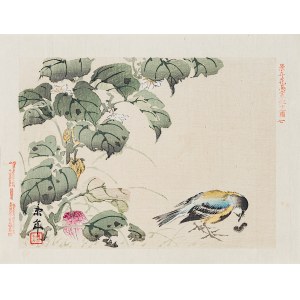Japanese woodcut, ink, paper, 21x27 cm (paper size), artist's signature, inscriptions in Japanese in the margins
An analogous woodcut is in the collection of the Rijksmuseum in Amsterdam and the British Museum in London. The work is from an album entitled: Keinen kacho gakan (Keinen's Album of Birds and Flowers) published in Osaka in November 1892 in collaboration with Aoki Kouzaburo. A total of 12 woodcuts were published in the album.
Imao Keinen (1845 - 1924) was a Japanese painter and graphic designer. Born in Kyoto, he studied classical Japanese painting, calligraphy and printmaking. Transitional phase changes between the Edo and Meiji eras around 1868 led his family business to bankruptcy. As a result, Keinen supported himself by earning a living as a textile designer. He later set up his own studio and became a painter and printmaker. In 1888, he was given a position as a professor at the Kyoto Prefectural School of Painting. In 1904, he was appointed chief artist of the imperial court. He specialized in kacho-ga, or paintings of birds and flowers with naturalistic details. He is best known for his album "Keinen Kacho Gafu,"(1891), consisting of 4 volumes of 40 graphics each. After the publication of this album, he became a member of the Art Committee of the Imperial Court, and in 1919 a member of the Imperial Academy of Fine Arts. His works are part of many museum collections around the world.
The term "kachō-ga" in Japanese is a combination of three words: "ka" - flower, "cho" - bird, "ga" - painting, so it literally means paintings of flowers and birds. In Far Eastern art, it is one of the leading artistic themes. It also encompasses plants, grasses, trees, animals, fish, insects - in fact, the entire living natural world except humans and landscapes. Kacho-e prints have been highly regarded for their beauty and accuracy, and have been widely collected both in Japan and abroad. The popularity of these prints is due in part to their reflection of traditional Japanese values and aesthetics, which placed a high value on harmony with nature. The woodcuts were often imbued with symbolic and allegorical meaning, such as the association of certain birds or flowers with certain seasons or features. The kachō-ga masters were driven by expression as well as emotion; they succeeded in capturing the colors and delicacy of flowers and the behavior of birds in the wild. Saturated with metaphorical meaning beyond their physical beauty, specific pairs of birds, insects and flowers became the basis of a tradition that continues to this day.








